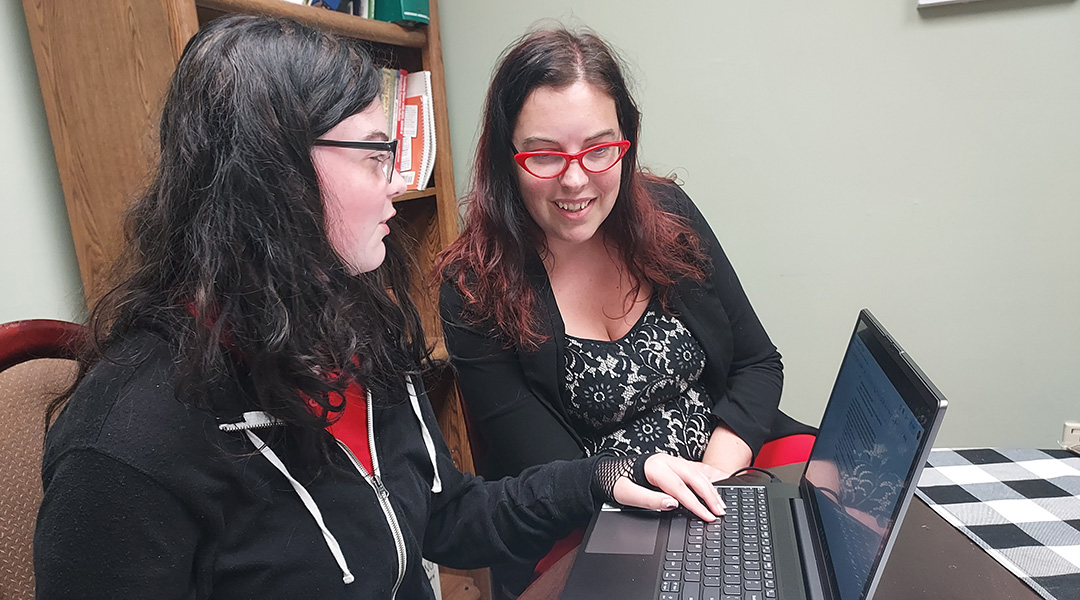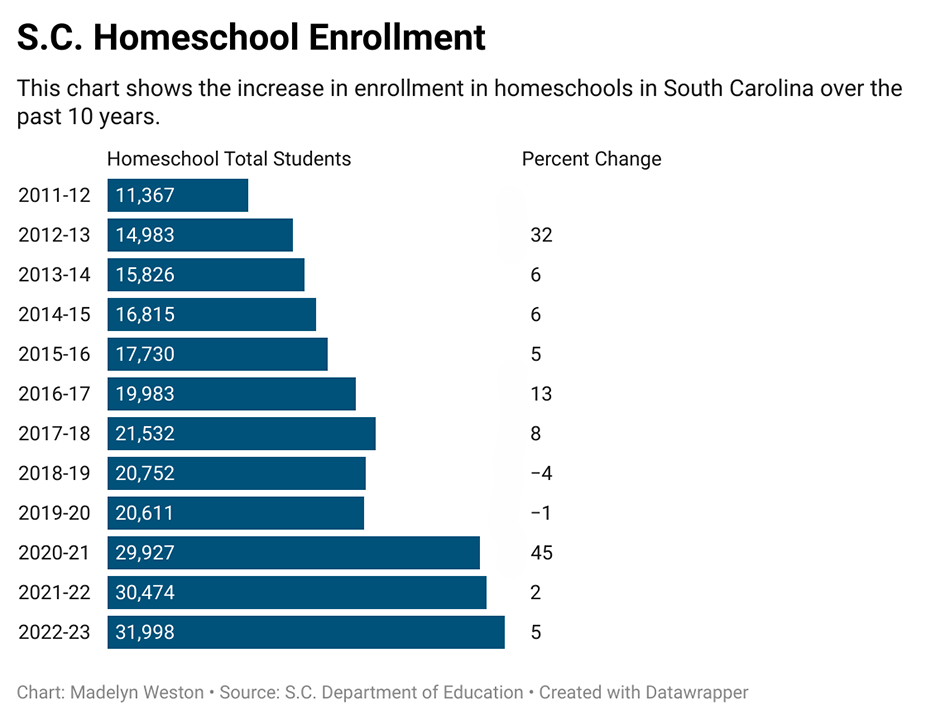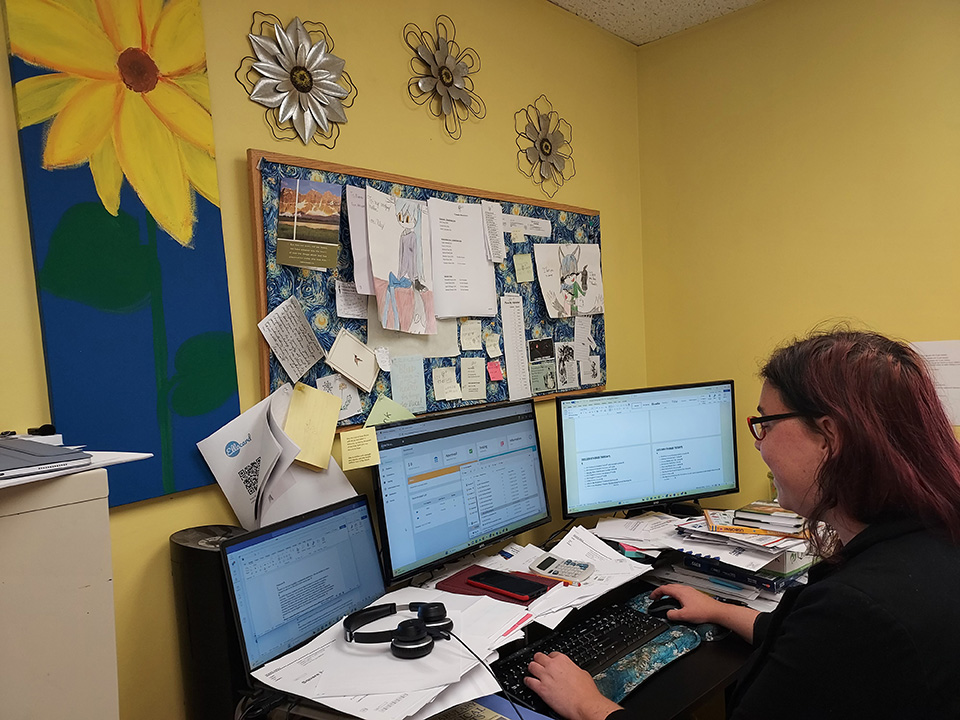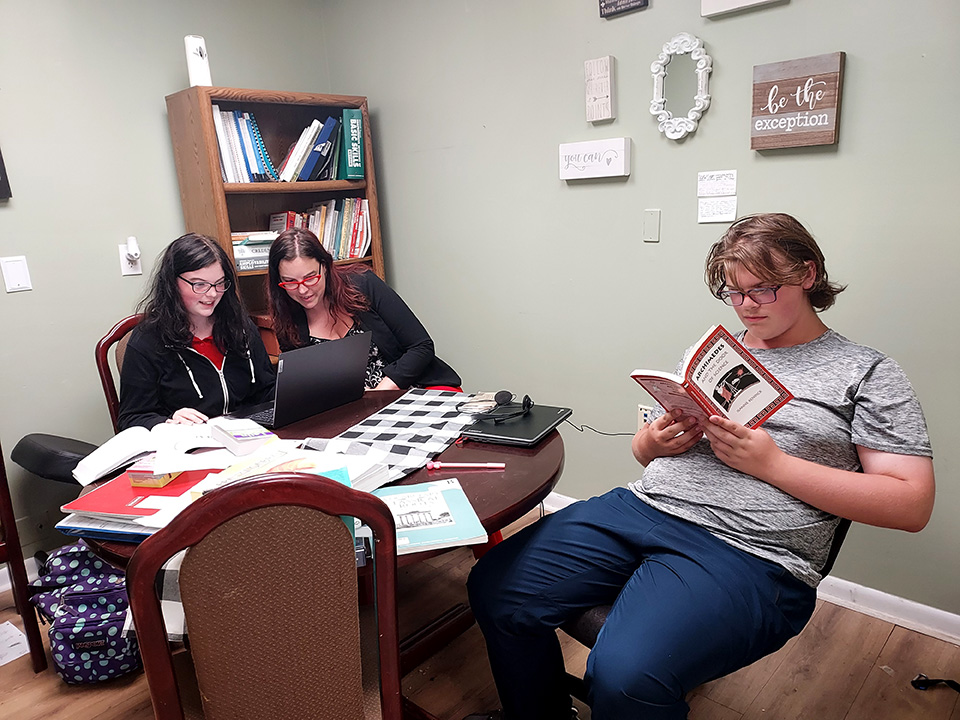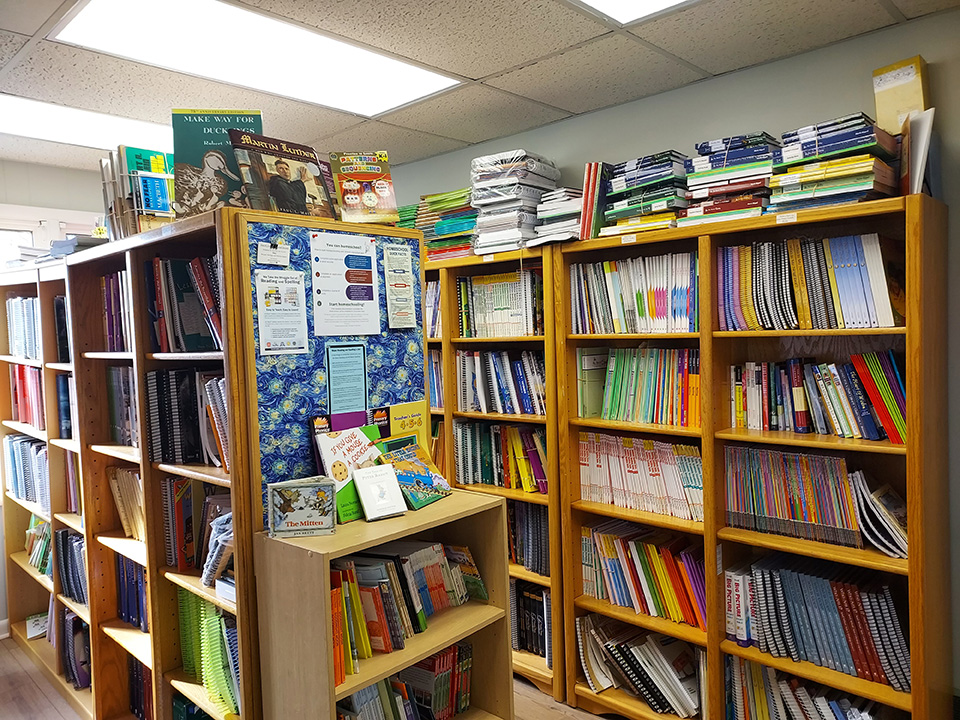Katina Prescott, right, teaches her daughter Riley. (Madelyn Weston/Carolina News and Reporter)
Homeschooling in South Carolina increased rapidly during the pandemic, and it remains popular in part because it can easily conform to students’ individual learning style.
Homeschool enrollment declined during the 2018-19 school year, according to a report by the state Department of Education. But enrollment jumped by 45% in the next academic year and has maintained a steady increase since.
Parents decide to homeschool their children because of concerns about peer pressure and safety, a desire to teach based on their morals or religion and to spend more time with family, according to a survey by the National Center for Education Statistics.
Parents who worked virtually during the pandemic got a taste for part- or full-time teaching when schools went online in 2020. Some parents still work from home, giving them a way to teach their kids while holding a job.
Zan Tyler, a homeschooling advocate, said parents gained confidence during the pandemic that they could teach their children. So they kept doing it, she said.
And many found they liked it.
Some homeschooling parents say they understand their kids and know their personalities, so they are better equipped to individualize lessons.
“I think a lot of parents realized that they could do it, and they liked having the time with their children,” Tyler said.
Flexibility in lesson plans in teaching is the key, homeschooling advocates say.
Kim Andrysczyk chose to homeschool her children to allow time for family goals and focusing on sibling relationships. Her children are close in age, so when they were younger, the family did a lot of group activities, she said. As the children got older, her teaching method became less group-oriented and more focused on individual responsibility.
“It’s a process to have agency and autonomy over your own educational learning,” Andrysczyk said.
She said people look for social connections, so finding the community where they belong is important.
“It’s personalized and individualized for what they are going through with their family,” Andrysczyk said. “They have to figure out their own personal goals and philosophies and also what works for the child.”
Parents don’t have to be alone in deciding what works best for their children.
Tyler and her husband founded the South Carolina Association of Independent Home Schools in 1990.
“Our goal was to provide educational counseling and support,” she said.
The homeschool association provides resources for families for visual, auditory and hands-on learning styles. Tyler said homeschooling can be more effective for children who understand hands-on learning because in a traditional classroom talking and moving around isn’t accepted.
“We really emphasize teaching according to your child’s learning style,” Tyler said. “It’s more personal, effective and efficient.”
Katina Prescott is the administrative director of the South Carolina Association of Independent Home Schools. She was studying to be a teacher when she realized that she didn’t want to work in a public school. So Prescott decided to homeschool her kids.
“It can be a difficult transition because you have to kind of teach yourself less about classroom management and more about how kids learn,” Prescott said. “There’s not a lot taught about how kids learn to public school teachers and private school teachers.”
Prescott’s two teenagers study while she works in the office. She teaches them one-on-one and sometimes combines lessons for subjects such as social studies. One benefit is if a child needs more time on a subject such as reading, they can focus on something else then try again when they’re ready, she said.
“I do really honestly believe that the one-on-one education is one of the best ways to go,” Prescott said. “If the child doesn’t understand, you can stop.”
Prescott’s daughter, Riley Prescott, is in 10th grade. She was homeschooled until sixth grade, then went to private school through this year and switched back to homeschool. Riley agrees working at her own pace is unique to homeschooling.
“Private school doesn’t have that,” she said. “You might be the only one who understands right off the bat. Or you might be the only one who doesn’t understand.”
Riley said the private school had a completely different curriculum, so she followed what returning students were doing.
Although students are working at their own pace, they still have a schedule.
A lot of parents teach the younger kids together, while the teenagers have individual lessons or work independently, Prescott said.
Many schools are seven hours long, while homeschoolers can finish in three to five hours.
Prescott said some families choose to homeschool because they’ll have time for other activities. The homeschool association connects families with groups of homeschool families called co-ops to keep their students involved in the community.
Homeschool support groups even coordinate field trips.
“They are socializing with adults and kids their age,” Prescott said. “These are skills that they’re going to need when they are out of school and not segregated by age.”
Also, having this style of schooling prepared them to use virtual learning or meet in small groups during the pandemic.
Chelsea Kibert co-founded Home Education Resource Organization in 2020 when her co-op shut down. She is one of the directors and schedules classes and extracurricular activities. Kibert said the homeschool organization was one of the only groups that continued leading in fall 2020.
“We required masks and we met at the park,” Kibert said. “It was nice because we were still able to have a sense of normalcy. We also ended up with a lot of people who found homeschooling because the e-schooling wasn’t working with their kids.”
The co-op had 44 kids enrolled in 2020, and it’s grown now to 160-170 students.
Home Education Resource Organization has classes from 9 a.m. to 2 p.m. and offers 97 courses for ages 3-18. Throughout the school year, Kibert schedules 4-6 field trips such as going to a pumpkin patch or Mount Vernon in Washington, D.C.
“I think the benefit of being a part of the co-op is probably opportunities because we have 40-50 moms planning activities, so you could never do that much on your own,” Kibert said.
One mom has a chemistry background, so she teaches a higher level class. The nonprofit organization has a drama program with a yearly production and a high school level physical education course. Kibert’s daughter has time to do 15 hours of martial arts.
The opportunity to enroll her grandson online for homeschooling was appealing to Doris Meriwether. She found an online homeschooling website called K12 .com when the public school district didn’t call consistently about his grades and she wasn’t satisfied with their ways of contacting her. The K12 classes meet online with a normal school schedule through a video call.
Her grandson has ADHD, and she thinks virtual school reduces the distractions. He got into fights and roamed the halls in public school. But, with online homeschooling, Meriwether makes sure he’s on task. The curriculum is the same as what he was learning in public schools. Her grandson can transition back when he’s ready.
“It’s less stressful, and I’m able to cope with him much better,” she said.
Katina Prescott sits at a desk with three computers and papers to work. (Madelyn Weston/Carolina News and Reporter)
Riley Prescott, left, shows her mother, Katina Prescott, what she has written on her laptop while her brother Elias reads. (Madelyn Weston/Carolina News and Reporter)
The library at the headquarters of the S.C. Association of Independent Home Schools has a variety of books and textbooks for a range of ages. (Madelyn Weston/Carolina News and Reporter)

